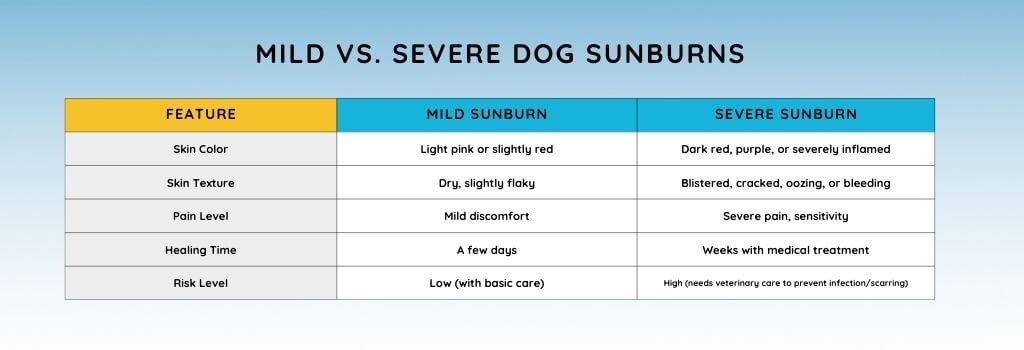When temperatures start to heat up and the days grow longer, people and their pets naturally begin spending more time outdoors exploring nature, catching up on yard chores, or simply soaking up the sunshine. Just like us, most dogs enjoy the warmer weather. As pet parents, we fill their days with walks, games of fetch, and sunbathing while we take care of all the yard chores.
While some sun exposure is healthy and natural for dogs, owners should be aware of the risks of their dogs spending too much time out in the sun. Most dog owners are familiar with heat-related conditions like heatstroke and dehydration and do their best to provide shade, fresh water, and cool places for their pets to rest. But there's one risk that often goes unnoticed: sunburn - and it can have serious consequences.
In this blog, we'll cover everything you need to know about dog sunburns, including how to recognize the signs, which dogs are most at risk, how to treat sunburns, and when it's time to call your veterinarian.

Can Dogs Get Sunburn?
YES! Even though their fur offers some protection, it doesn't block all UV rays. Dogs are especially vulnerable to the damaging effects of the sun during peak UV hours – typically 10 a.m. to 4 p.m. – particularly when they're outside for extended periods without access to shade or protective gear.
Sunburn is most likely to occur during the spring and summer months when UV levels are highest - especially on clear, sunny days. Certain areas of a dog's body are more prone to sunburn due to thinner fur or exposed skin:
- Ears (tips and edges)
- Nose
- Eyelids
- Mouth (lips and edges)
- Belly
Surprisingly, signs of sunburn can appear in as little as 30 minutes of direct sun exposure under the right conditions.
Factors That Can Contribute to Sunburn in Dogs
While any dog can get sunburned, certain factors make some dogs more susceptible:
- Light-colored dogs (white, cream, ginger) with fair skin underneath
- Short-haired breeds like Pit Bulls, Boxers, Dalmatians, and Greyhounds
- Hairless breeds like the Chinese Crested or American Hairless Terrier
- Dogs with bald spots or areas of thin fur
- Dogs who spend a lot of time outdoors
If your dog doesn’t have any characteristics included on that list, that doesn’t mean you’re in the clear. Any dog can suffer from a sunburn under the right conditions, so it’s crucial for owners to monitor their dog’s time outside in the sun and take the proper precautions to fully protect their dog’s skin.
Untreated sunburns can lead to complications like infections, skin damage, and even skin cancer. Preventing sunburn should be a priority whenever your dog is outdoors for an extended period of time.
Signs Your Dog Has a Sunburn (And When You Need to See a Vet)
So, what does a sunburn look like on a dog? Mild burns may be subtle, but the symptoms are often similar to what we experience ourselves.
Common signs of sunburn in dogs include:
- Pink or red skin, especially in exposed areas
- Warm, dry, or tender skin
- Flaky patches of skin
- Excessive scratching or licking
- Curling or dryness on the edges of the ears
- Hair loss around the affected area
Signs of severe sunburn include:
- Mild fever
- Lethargy or discomfort
- Skin turns dark red or purple
- Sores or blisters on the skin
- Your dog stops eating or drinking
- Signs of dehydration (lethargy, dry gums)
- Severe pain
If your dog exhibits anyt of the more severe symptoms of sunburn, seek veterinary care immediately. Sunburn can quickly escalate and results in infection, serious pain, or other complications.

How to Treat a Dog’s Sunburn
How to treat a dog sunburn will primarily depend on the sunburn’s severity. Let’s take a closer look at the varying degrees of sunburns in dogs and what treatment options are available for them.
Mild Dog Sunburn
Mild sunburns don’t require much treatment, and owners will typically need to focus on keeping their dog comfortable over the next few days while the sunburn and any accompanying side effects like itching or skin tenderness resolve on their own.
If your dog has slightly pink skin and no pain, you can try:
- Use cool compresses on the area.
- Try a gentle oatmeal bath in cool/room temperature water.
- Apply pet-safe aloe vera (no added alcohol or fragrances).
Moderate to Severe Dog Sunburn
Moderate to severe sunburns in dogs are a much more serious matter and will require professional attention, as they are often painful and prone to infection. These sunburns are typically very uncomfortable or even painful for dogs and have the potential to do lasting damage to a dog’s skin.
If the symptoms of your dog’s sunburn worsen or new signs appear, contact your veterinarian. Depending on the severity of the burn, treatment options employed by your veterinarian may include:
- Pain relief medications
- Antibiotics for infection
- Topical creams or ointments
Be sure to keep your dog completely out of the sun until they are fully healed. After recovery, protective measures are crucial to prevent future sunburn and reduce the risk of skin cancer.
If you have questions and you'd like to reach out to us, you can call us directly at (218) 692-4400, or you can email us at [email protected]. Don't forget to follow us on social media Facebook, Instagram.

